
Send us an Email
For general hypnotherapy please visit The Apple Tree

For general hypnotherapy please visit The Apple Tree

A visit to London with a difference
Explore your spiritual inheritance, improve your psychic abilities, progress on your spiritual path and create the life you want!

You will have the unique opportunity to …
~ speed up your progress on your spiritual path by revising your past lives and exploring your future;
~ discover your true psychic potential and learn how to master it;
~ take control of your life by learning how to get what you want and deserve from life;
~ learn how to get in touch with your inner Self and how to communicate with it;
~ enjoy the pleasure and excitement to be among like-minded, supportive people;
~ visit the most lively and fashionable city in Europe, enjoying its culture, its entertainments and its shopping,
while residing in charming and peaceful surroundings, rich in tradition and history.
Three days of fun and laughter mixed with powerful spiritual epiphanies and deep self-discoveries
in a friendly and relaxing environment, facilitated by a highly qualified and experienced hypnotherapist and trainer who has studied with Dr Brian Weiss.

According to the Guinness World Records, London is the most popular city with tourists, receiving the world record of
16.9 million international visitors in 2012.
Are you considering visiting London?
Choose an unusual, exciting alternative to the traditional tours!
Find the London that tourist guides can never tell you about.
Discover a different, seductive London with the insightful suggestions of the locals!
Enjoy an unusual holiday in a fashionable, vibrant capital city, combining culture, entertainment and shopping with
spiritual growth and Self-Improvement techniques.


Whether you live far away or nearby, take advantage of the opportunity to attend three days of uplifting, spiritual and healing experiences in a friendly environment and – at the same time – discover an area which, although less widely known than the centre of the capital, is nonetheless rich in artistic, cultural and natural treasures, besides offering first-class shopping at lower prices than Central London.
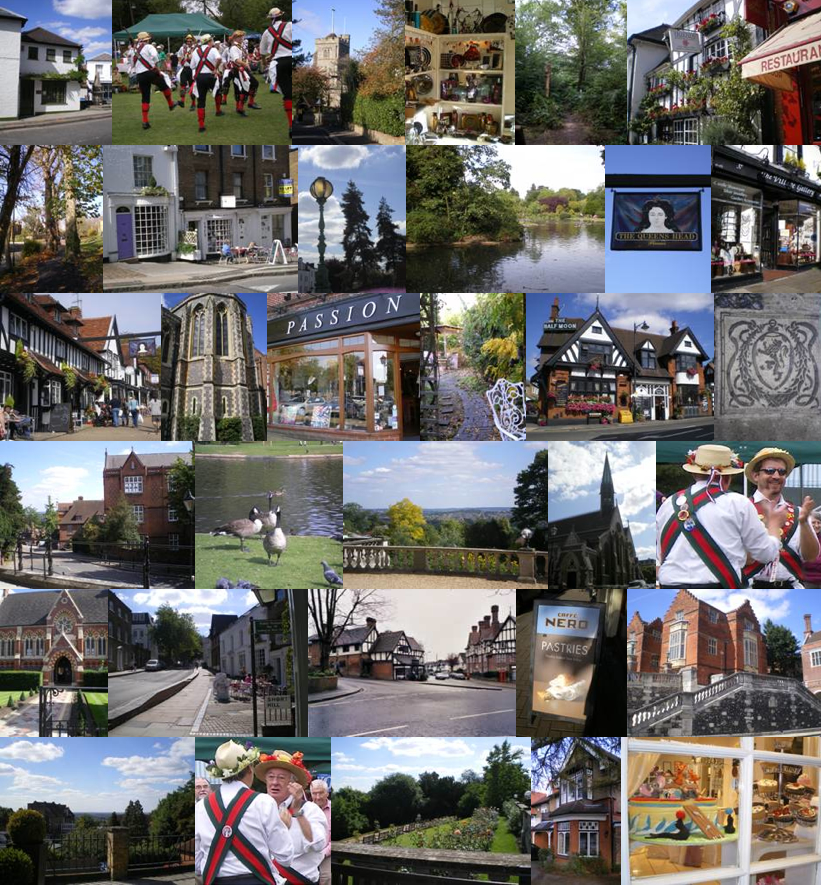


We are located in Harrow, an elegant and leafy area in the North West of London, only 20 minutes from the Centre with its multicultural society, West End theatres, Covent Garden, Oxford Street, museums and parks. The Harrow area is rich in history, traditions and attractions and will open its doors to exciting discoveries of a different, lesser-known London and to new, unexpected vistas.
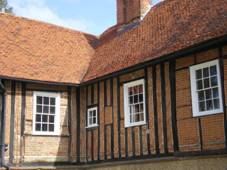
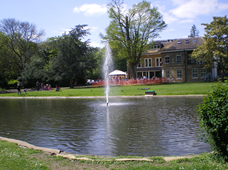 Depending on the availability of the rooms and the number of participants the workshops will be held either at our practice in North Harrow or at the Tudor Lodge hotel in Eastcote (beside the Walled Garden and a few minutes from Eastcote station). This elegant, 3 star hotel (a Grade II listed building) is the result of a skilled conversion of an important farmhouse, dating back to the 15th century. It has preserved a warm charm that is enhanced and complemented by modern-day facilities.
Depending on the availability of the rooms and the number of participants the workshops will be held either at our practice in North Harrow or at the Tudor Lodge hotel in Eastcote (beside the Walled Garden and a few minutes from Eastcote station). This elegant, 3 star hotel (a Grade II listed building) is the result of a skilled conversion of an important farmhouse, dating back to the 15th century. It has preserved a warm charm that is enhanced and complemented by modern-day facilities.
If for any reason this venue is not available the workshop will be held either at Manor Farm, a charming and evocative medieval farm in Ruislip (now a museum), near Ruislip station, or at the historic West House in the Memorial Park in Pinner, which houses a museum of the illustrator and cartoonist William Heath Robinson who lived in Pinner at the beginning of the 20th century. The morning of the third day (in the Tourist version) will be at the historic Walled Garden of Eastcote House (further details will be given during the workshop).
Being an attractive area, with connections to Central London and at the same time enjoying lower prices and peaceful and relaxing surroundings, Harrow has a lot to offer the discerning visitor: a large selection of hotels and B&Bs are available, often nestled in quiet, residential tree-lined roads with charming, traditional architecture.
Because we live locally we shall be able to advise you on the best and most convenient choices: you will be able to rely on us for your entire stay. When you register we shall provide you with all the details you need in order to make an informed choice, the perfect choice for you.
You can find elegant and cosy B&Bs with single rooms for as little as £40, double rooms for £60 and triple rooms for £75 at 10 minutes’ walk from our practice (contact us for more details).
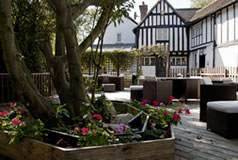
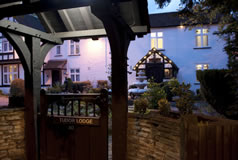 The Tudor Lodge has agreed to offer a special reduced price to all the participants of our workshop. This hotel in itself is worth a visit for its old and interesting history and it represents a perfect setting for our workshops, besides being conveniently located at only a few minutes on foot from the historic Walled Garden that we shall explore on the third day. The hotel was built some 500 years ago in the 15th century, when Christopher Columbus was busy discovering America, and more than 100 years before the Pilgrim Fathers sailed in the "Mayflower".
The Tudor Lodge has agreed to offer a special reduced price to all the participants of our workshop. This hotel in itself is worth a visit for its old and interesting history and it represents a perfect setting for our workshops, besides being conveniently located at only a few minutes on foot from the historic Walled Garden that we shall explore on the third day. The hotel was built some 500 years ago in the 15th century, when Christopher Columbus was busy discovering America, and more than 100 years before the Pilgrim Fathers sailed in the "Mayflower".
The hotel, now a grade II listed building, was originally an important farmhouse in the district.
Since then the Tudor Lodge Hotel has seen plenty of history down through the ages as well as many troubled times, from the harsh period of Cromwell through to the days when it was established as a hospital for sick and wounded soldiers during the great war of 1914—1918. In the early 1970s Tudor Lodge was purchased by Jeffrey Landless, a direct descendent of the famous “Scottish Robin Hood” Rob Roy.
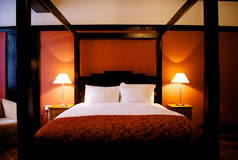
 The property has been developed in the 90's into the attractive hotel that it is today. Carefully and lovingly modernising the furnishings to provide up-to-date facilities with a high level of comfort — the Tudor Lodge Hotel still retains its unique and authentic 15th Century character and charm, evident from the rustic ambience of its restaurant and the lobby bar. With the addition of a newly built annex of 16 en-suite bedrooms in 2003, all the rooms are now equipped with colour television, internet access, direct-dial telephones, and tea/coffee making facilities.
The property has been developed in the 90's into the attractive hotel that it is today. Carefully and lovingly modernising the furnishings to provide up-to-date facilities with a high level of comfort — the Tudor Lodge Hotel still retains its unique and authentic 15th Century character and charm, evident from the rustic ambience of its restaurant and the lobby bar. With the addition of a newly built annex of 16 en-suite bedrooms in 2003, all the rooms are now equipped with colour television, internet access, direct-dial telephones, and tea/coffee making facilities.
There is a one-day laundry and dry cleaning service, automatic early morning call system, and naturally, in spite of its antiquity, the hotel has full central heating.
[Information courtesy of Tudor Lodge hotel. To read more about this charming hotel, its rich past and its modern facilities please visit their website at www.thetudorlodge.net]

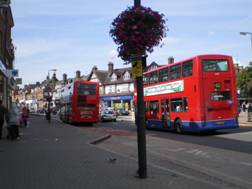 To and from London’s Airports – Harrow can be easily reached by public transport from all London airports; the most convenient being Heathrow (by underground Piccadilly Line) and Stansted (Stansted Express and underground Metropolitan Line).
To and from London’s Airports – Harrow can be easily reached by public transport from all London airports; the most convenient being Heathrow (by underground Piccadilly Line) and Stansted (Stansted Express and underground Metropolitan Line).
To and from Central London – There are five stations in Harrow, served by four underground lines (Metropolitan-Uxbridge Branch; Metropolitan- Watford Branch; Piccadilly-Uxbridge Branch and Bakerloo) and two overground lines, with direct connections to the London stations of Marylebone, Paddington, Baker Street, Euston, King’s Cross, Charing Cross and Liverpool Street. A good network of buses provides quick and efficient local connections.
Motorways: We are near the M1, M25 and M4.
When you book we shall send you a list of hotels, B&Bs, travel information to and from Central London and details of the cheapest ways to travel to and from the airports and around London, including all the necessary internet links.

![]()
Bringing you the experience gained under the guidance of Dr Brian Weiss, the international, undisputed Number 1 authority on Past Life Regression, Interlife Exploration and Future Life Progression.
You will experience plenty of relaxing inductions which will wonderfully stimulate your imagination and your creativity, boosting your self-esteem and widening your horizons. You will discover and explore the spiritual depths inside your soul. There will also be plenty of time for discussions and for dealing with any questions you may wish to ask.
On our page List of Our Workshops: Spiritual Adventures we give a short summary and presentation of all our workshops. We regularly update the contents of our workshops. Please email us directly to request the most recent version of our detailed programmes, specifying which workshop/s you are interested in. We shall also send you the practical information regarding the venue of the event and the accommodation options available (if you need to stay overnight).
The three-day workshop, Experiencing Past Life Regression and other spiritual techniques, is offered in two versions:
Standard version: all sessions are held at the same venue and they alternate theoretical parts with practical ones.
Tourist version: on the morning of the third day the workshop is held at the historic Walled Garden of Eastcote House (in Eastcote).
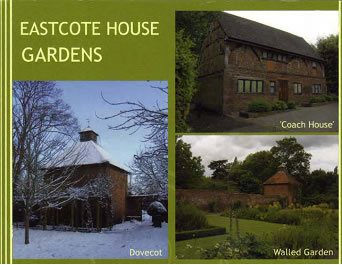 There will be a guided tour of the ancient Walled Garden of Eastcote House and of the Coach House. You will also have the opportunity to explore the grounds of this historic garden and surrounding park, and meditate on the mandala (or more precisely yantra) it represents. Carl Gustav Jung saw the mandala as "a representation of the unconscious self”, and believed his paintings of mandalas enabled him to identify emotional disorders, leading towards wholeness in personality.
There will be a guided tour of the ancient Walled Garden of Eastcote House and of the Coach House. You will also have the opportunity to explore the grounds of this historic garden and surrounding park, and meditate on the mandala (or more precisely yantra) it represents. Carl Gustav Jung saw the mandala as "a representation of the unconscious self”, and believed his paintings of mandalas enabled him to identify emotional disorders, leading towards wholeness in personality.
You will also have an opportunity to experience an induction in an outdoor setting, so that the outer garden can merge with your inner garden to reach spiritual wholeness. If weather conditions do not allow it, the induction will be held in the charming old Dovecot*, which still retains the peaceful energy of the gentle doves who lived there centuries ago. In all ages and cultures birds have symbolised the soul because of their similarity to angels. Doves in particular are a symbol of peace and love.
In the afternoon we shall return to the workshop venue as a group or individually.
[Dovecot(e): Circular, polygonal, rectangular, or square building, like a short tower, called columbier or columbarium, the interior of which is fitted with small niches (columbaria) all round the walls for nesting pigeons or doves. If it is a tall building it is called a dove-tower (http://www.encyclopedia.com/doc/1O1-dovecote.html)].
Both versions are intensive and bring us to work closely together. The atmosphere is friendly, supportive and very informal. Comfortable clothes are recommended in order to feel at ease at all times: although the chairs are comfortable, some people may prefer to lie on the carpeted floor when the workshop is held at Tudor Lodge.

- Detailed information about transport and accommodation;
- 3 intensive days of uplifting, life-changing experiences;
- Lunch and Refreshments;
- A guided tour of the historic Walled Garden in Eastcote with an open-air induction (Tourist Version only);
- Full support and advice during your entire stay in Harrow;
- Various workshop material and useful information, links and maps for your London visit in both print and electronic formats;
- FREE booklet with the history of Eastcote House (Tourist Version only);
- FREE Subliminal CD to boost your Self-Confidence.
Our Rainbow Collection series of CDs will be available to all Participants at a special reduced price. One-to-one sessions can be arranged on request.
The course is designed to run on three consecutive days (Friday to Sunday or Saturday to Monday). However, if – due to working commitments or any other reason – you prefer to have the workshop organised on separate dates (like three consecutive Sundays or a full weekend plus one Saturday or Sunday), please let us know: we may be able to help you. It will be group work and if the other participants are happy to split the workshop into two or three separate meetings we may be able to arrange it.
The venue of the workshop may change from time to time, depending on the number of participants and availability of the rooms. Please contact us directly to know where the next workshop will be held. If it is held at the charming and evocative Tudor Lodge Hotel in Eastcote, Middlesex (which occupies the premises of a 15th century farm), a special discounted price will be offered to all participants who decide to stay at the hotel during our workshops. They will be able in this way to enjoy the advantages of a full-immersion, residential course. For those interested in this option I can recommend, for the evening meal, an inexpensive pizzeria in the area (appropriately called Karma Free) run by one of my former students.
Please contact us for new dates.
A deposit of £150 is required to reserve your place and the balance needs to be paid at least 30 days before the starting date.
Despite our best efforts, dates and venues on the websites may be subject to change (please contact us for confirmation).
Let us know if you are interested in alternative dates and do not hesitate to contact us by phone or email click HERE) if you need more information or if you want to discuss any specific requirements you may have.



Eastcote Village was first documented in 1248 as Estcotte. It is later also recorded as Estcote (1296), Astcote (1435), Eastcot (1822). The name means ‘eastern cottage(s)’, from old English ēast and cot, a hamlet so named from its situation east of Ruislip and contrasting with another hamlet called Westcott in 1780 (but certainly much older than this).*
Eastcote House was unfortunately demolished in 1964. It had developed over the centuries from a Tudor house to a mansion. Each generation added to the main body of the building.
There were cellars under the House, and it is thought that much of the fabric of the building was pushed into them at demolition. If the Heritage Lottery Fund grant is obtained, a full archaeological dig on the site of the old house and a full Archaeological Forensic survey of the building will be carried out. We may then learn its secrets.
Late Iron Age pottery shards were found in 2007 at the nearby site of Bishop Ramsey School. Both Eastcote House Gardens and Highgrove Woods [next to Bishop Ramsey School] have Sarsen stones, therefore it is possible that Iron Age remains exist at Eastcote House Gardens. Both sites are listed as Sites of Importance for Nature Conservation.
The surviving buildings at Eastcote House Gardens (the Coach House, the Dovecot and the Walled Garden) became Grade II Listed Buildings in 1972. This was the first time the Coach House was referred to as such: all previous documentation refers to Stables. The London Museum and English Heritage now consider the building to be older than first thought (c. 17th century) and English Heritage are now going to dendro-date the timbers of the Coach House.
Sarsen stone [probably a variant of Saracen] is one of the large sandstone blocks scattered over the English chalk downs. It is a boulder of silicified sandstone, probably of Tertiary age, found in large numbers in S. England. Such a stone was used in megalithic monuments and it is also known as greywether or Druid stone.
The Walled Garden as a Spiritual Retreat (by R.M. Pinkerton, 2010)
When people come to Eastcote House Walled Garden they often remark on how peaceful it is or that they find peace by walking in or sitting down within it. Yet only a short way away outside the walls are open grass areas where no such feelings arise and a busy road which can be heard within the garden. What they perhaps don’t realise is that the walled garden and its four-fold design is an age-old religious symbol which, consciously or unconsciously, touches something deep within everyone.
In ancient Greece, and Rome the temenos was an enclosed area (often a grove) and at its centre the god was to be found. A walled area accentuates the feeling of a sacred and safe place and also a secret place. The flowers and bushes serve to bring us into contact with nature and its beauty and variety.
Frances Hodgson Burnett captures this feeling in her novel, The Secret Garden, which becomes a place of rejuvenation and of healing for the main character, a lonely girl and her companion, a little boy, who suffers from a paralysis mainly psychological in nature.
Added to the symbolism of the walled garden is its pattern. The Eastcote House Walled Garden is divided by paths into four areas of equal size, a quarternity, with each quarter having a rectangular flower-bed at its centre. In the centre of the whole garden is a sundial. The whole pattern is the shape 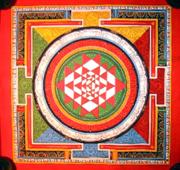 of a religious symbol found throughout the ages in all religions, but particularly in Hinduism and Buddhism, where it is called a mandala. A mandala is a symbol of wholeness. The numbers four and eight always show something that is whole and complete, such as the four points of the compass or the four humours of medieval medicine. The mandala can take many forms but always with a four-fold or eight-fold structure and a god, or a symbol of a god at its centre. A Christian example of a mandala, often found in churches, is of the four evangelists at four points of the compass, with Christ in the centre.
of a religious symbol found throughout the ages in all religions, but particularly in Hinduism and Buddhism, where it is called a mandala. A mandala is a symbol of wholeness. The numbers four and eight always show something that is whole and complete, such as the four points of the compass or the four humours of medieval medicine. The mandala can take many forms but always with a four-fold or eight-fold structure and a god, or a symbol of a god at its centre. A Christian example of a mandala, often found in churches, is of the four evangelists at four points of the compass, with Christ in the centre.
The mandala in its many forms is a symbol that often occurs in dreams of people experiencing a crisis of some sort. The dream provides reassurance and a feeling of restored health or integrity.
As with the walled area itself, the mandala has an unconscious effect on people as it touches something deep within, and is what C.G. Jung called an archetype. All gardens carry the archetype of the temenos but one like the Eastcote House Walled Garden with its mandala pattern produces a much greater effect on people. All the more reason why we should value and care for it and keep it as a place where people want to come for the peace and beauty it provides.
Temenos (τέμενος, from the Greek verb τέμνω "to cut"; plural: τεμένη, temene) is a piece of land cut off and assigned as an official domain, especially to kings and chiefs, or a piece of land marked off from common uses and dedicated to a god, a sanctuary, holy grove or holy precinct: The Pythian race-course is called a temenos, the sacred valley of the Nile is the Νείλοιο πῖον τέμενος Κρονίδα, the Acropolis is the ἱερὸν τέμενος (of Pallas).
The concept of temenos arose in classical Mediterranean cultures as an area reserved for worship of the gods. Some authors have used the term to apply to a sacred grove of trees, isolated from everyday living spaces, while other usage points to areas within ancient urban development that are parts of temples.
A large example of a Bronze Age Minoan temenosis at the Juktas Sanctuary of the palace of Knossos on ancient Crete in present day Greece, the temple having a massive northern temenos. Another example is at Olympia, the temenosof Zeus. There were many temene of Apollo, as he was the patron god of settlers.
In religious discourse in English, temenos has also come to refer to a territory, plane, receptacle or field of deity or divinity.
C.G. Jung relates the temenos to the spellbinding or magic circle. (Adapted from http://en.wikipedia.org/wiki/Temenos).
A magic circle is a circle or sphere of space marked out by practitioners of many branches of ritual magic, either to contain energy and form a sacred space, or as a form of magical protection, or both. It may be marked physically, drawn in salt or chalk, for example, or merely visualised. Its spiritual significance is similar to that of mandala and yantra in some Eastern religions. (Adapted from http://en.wikipedia.org/wiki/Magic_circle).
For Yantras see: http://en.wikipedia.org/wiki/Yantra and for Mandalas see: http://en.wikipedia.org/wiki/Mandala.
For more information about the Walled Garden and Eastcote House see: http://www.hillingdon.gov.uk/media/pdf/h/r/eastcote_house_gdns_mgmt_plan2010.pdf and http://www.eastcotelocal.co.uk/eastcotehousegardenszeronine.aspx


If you want to take advantage of your stay in Harrow to visit Central London, you are only 20 minutes away, with trains every few minutes – however why not be tempted by the exciting opportunity to discover new artistic and natural horizons and new realities of London life and surprise your friends and your family, when you go home, with beautiful unexpected photos and treasured memories?
In the Harrow area you will be spoilt for choice and you will see that the time will fly: from natural beauty, peaceful living and historical treasures to elegant shopping and attractive international cafés and restaurants.
The earliest record of the name, Gumeninga hergae appears in 767 and means ‘the heathen shrine(s) [or temple(s)] of the Gumeningas’. The Gumeningas were a mysterious tribe about whom we don’t know anything else, not even the origin of their name. Subsequent attested forms are: Hearge (825), Hergas (832) (all Anglo-Saxon characters), Herges (1086 - Domesday Book), Herwes (1234), Harwes (c.1250), Harwe (1278), Harowe (1369), which means ‘the heathen shrine(s)’ or ‘temple(s)’, (from Old English hearg, with alternating singular and plural forms in early records). The fuller name Harrow-on-the-Hill is first found at the end of the 14th century, as Harowe atte Hille (1398) and Harowe on the Hill (1426), from Middle English hill. The prominent hill here (408 ft), now crowned by the church of St Mary – partly dating back to the 11th century – was clearly an important site of pagan worship before the conversion of the Anglo-Saxons to Christianity (early 7th century onwards).*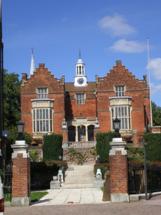
 The Old English hearg corresponds to Old Norse hörgr (plural hörgar). It was a type of religious building or altar possibly consisting of a heap of stones, used in Norse paganism. Hörgrs are attested in the Poetic Edda, compiled in the 13th century from earlier traditional sources; the Prose Edda, written in the 13th century by Snorri Sturluson, sagas, in the poetry of skalds, the Old English poem Beowulf, and in various place names, often in connection with Germanic deities. (Adapted from http://en.wikipedia.org/wiki/Hörgr).
Heathen hofs, or Germanic pagan temples, were the temple buildings of Germanic paganism. The term hof is taken from Old Norse. Etymologically, the Old Norse word hof is the same as the German word hof, meaning a farm, and this is still its primary meaning in some Scandinavian languages. During the Viking Age, it appears to have displaced older terms for a sacred place, vé, hörgr, lundr, and vin, particularly in the West Norse linguistic area, namely Norway and Iceland. It is the dominant word for a temple in the Icelandic sagas. Many places in Scandinavia, but especially in West Norse regions, are named hof or hov, either alone or in combination. The Latin historian Tacitus wrote in his Germania (ch.9): “The Germans do not think it in keeping with the divine majesty to confine gods within walls or to portray them in the likeness of any human countenance. Their holy places are woods and groves, and they apply the names of deities to that hidden presence which is seen only by the eye of reverence”.
The Old English hearg corresponds to Old Norse hörgr (plural hörgar). It was a type of religious building or altar possibly consisting of a heap of stones, used in Norse paganism. Hörgrs are attested in the Poetic Edda, compiled in the 13th century from earlier traditional sources; the Prose Edda, written in the 13th century by Snorri Sturluson, sagas, in the poetry of skalds, the Old English poem Beowulf, and in various place names, often in connection with Germanic deities. (Adapted from http://en.wikipedia.org/wiki/Hörgr).
Heathen hofs, or Germanic pagan temples, were the temple buildings of Germanic paganism. The term hof is taken from Old Norse. Etymologically, the Old Norse word hof is the same as the German word hof, meaning a farm, and this is still its primary meaning in some Scandinavian languages. During the Viking Age, it appears to have displaced older terms for a sacred place, vé, hörgr, lundr, and vin, particularly in the West Norse linguistic area, namely Norway and Iceland. It is the dominant word for a temple in the Icelandic sagas. Many places in Scandinavia, but especially in West Norse regions, are named hof or hov, either alone or in combination. The Latin historian Tacitus wrote in his Germania (ch.9): “The Germans do not think it in keeping with the divine majesty to confine gods within walls or to portray them in the likeness of any human countenance. Their holy places are woods and groves, and they apply the names of deities to that hidden presence which is seen only by the eye of reverence”.
These pagan “temples” were common to a large area of Europe, covering all the Northern part from Germany to the Scandinavian countries and including also Iceland. The Anglo-Saxons brought their religion to England, where it mixed with the existing, similar Celtic paganism. The name given to the shrine on the top of the Hill (from which the name Harrow comes) is proof of the influence and establishment of Northern religious belief and tradition on English soil. (Adapted from http://en.wikipedia.org/wiki/Heathen_temple: for a more detailed analysis of the nature of these temples and their area of diffusion and what they actually were, see the full article).
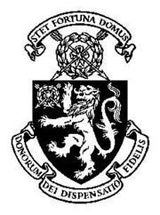 Harrow-on-the-Hill is home to the internationally renowned independent Harrow School, also known as Harrow Old School or simply – as more commonly referred to – “Harrow”. It is one of the original nine English public schools as defined by the Public Schools Act 1868 and has an enrolment of approximately 800 boys, spread across twelve boarding houses all of whom board full time. The Harrovian school has educated boys since 1243, but was officially founded by a local yeoman farmer, John Lyon (whose family is recorded in the neighbourhood from the 13th century) under a Royal Charter of Elizabeth I in February 1572. The school has many traditions and rich history, which includes the use of boaters, morning suits, top hats and canes as uniform as well as well as a very long line of famous alumni including eight former Prime Ministers (among whom Winston Churchill, Jawaharlal Nehru and Henry John Temple, 3rd Viscount Palmerston), numerous foreign statesmen, former and current British Lords and members of Parliament, two Kings and several other members of various royal families, 19 Victoria Cross holders, and a great many notable figures in both the arts and the sciences. Old fictional Harrovians include the character Withnail from the film Withnail and I. (Adapted from http://en.wikipedia.org/wiki/Harrow_on_the_Hill and http://en.wikipedia.org/wiki/Harrow_School).
Harrow-on-the-Hill is home to the internationally renowned independent Harrow School, also known as Harrow Old School or simply – as more commonly referred to – “Harrow”. It is one of the original nine English public schools as defined by the Public Schools Act 1868 and has an enrolment of approximately 800 boys, spread across twelve boarding houses all of whom board full time. The Harrovian school has educated boys since 1243, but was officially founded by a local yeoman farmer, John Lyon (whose family is recorded in the neighbourhood from the 13th century) under a Royal Charter of Elizabeth I in February 1572. The school has many traditions and rich history, which includes the use of boaters, morning suits, top hats and canes as uniform as well as well as a very long line of famous alumni including eight former Prime Ministers (among whom Winston Churchill, Jawaharlal Nehru and Henry John Temple, 3rd Viscount Palmerston), numerous foreign statesmen, former and current British Lords and members of Parliament, two Kings and several other members of various royal families, 19 Victoria Cross holders, and a great many notable figures in both the arts and the sciences. Old fictional Harrovians include the character Withnail from the film Withnail and I. (Adapted from http://en.wikipedia.org/wiki/Harrow_on_the_Hill and http://en.wikipedia.org/wiki/Harrow_School).
Harry Potter at Harrow: Harrow Old School or Hogwarts? The first film of the Harry Potter saga uses locations pieced together from sites across the length and breadth of the UK. For instance, although the elaborate exterior of ‘Hogwarts School’ is largely computer generated, scenes inside the school were filmed in at least six different locations, ranging from County Durham in the north of England to Wiltshire in the west. Professor Flitwick’s Charms Class, where Hermione (Emma Watson) manages to levitate a feather: “Wingardium Leviosa!”, is the Fourth Form Rooms of Harrow Old School. (Adapted from http://www.movie-locations.com/movies/h/harry_potter1.html).
If you are interested in visiting all the London locations of Harry Potter’s films you can check this website: http://www.londontaxitour.com/london-taxi-tour.htm
Today Harrow-on-the-Hill happily mixes the most traditional British charm with an old-style Continental flavour, with its cosy cafés, elegant traditional houses and winding little streets. Its beautiful architecture, elegant gardens and stunning views of the entire valley and of London itself will make your visit to Harrow-on-the-Hill a memorable one.
Pinner Village has its origins in a medieval hamlet which was first mentioned in 1232, the year in which we find a village called Pinnora, although the already archaic -ora (meaning 'hill') suggests its origins lie no later than c.900. More variants, like Pinnore (1248), Pinnere (1332) and Pynnor (1483), are attested in the following centuries and they all derive from two Old English words (pinn and ora), intended to mean “peg-shaped hill” or “pointed flat-topped hill”, which refers to the elongated ridge in Pinner Park to the south of which is Nower Hill, which is derived from the same word. Pinner Park (as well as Pinner Green) is mentioned in the Ordnance Survey map of 1822. It is also referred to earlier as Park of Pynnore (1348). It was originally a medieval deer park belonging to the Archbishops of Canterbury who were lords of the manor of Harrow in medieval times. Pinnerwood Park is named from Pinner Wood, marked thus on the Ordnance Survey map of 1822.*
The oldest part of the village lies around the fourteenth-century parish church of St John the Baptist, at the junction of the present day Paines Lane, High Street and Church Lane. The earliest surviving private dwelling, East End Farm Cottage, dates from the late fifteenth-century.
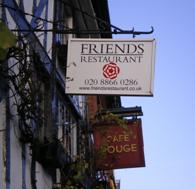 Pinner has had an annual street fair since 1336 when it was granted by Royal Charter by Edward III; it remains popular today, being the last of its kind in Middlesex, and featured in Sir John Betjeman's BBC TV documentary Metro-land (1973). The village expanded rapidly between 1923 and 1939 when a series of garden estates – encouraged by the Metropolitan Railway – grew around its historic core, and at this time assumed much of its present day suburban character. It is now continuous with the neighbouring suburban districts, including Rayners Lane, Hatch End, and Eastcote.
Pinner has had an annual street fair since 1336 when it was granted by Royal Charter by Edward III; it remains popular today, being the last of its kind in Middlesex, and featured in Sir John Betjeman's BBC TV documentary Metro-land (1973). The village expanded rapidly between 1923 and 1939 when a series of garden estates – encouraged by the Metropolitan Railway – grew around its historic core, and at this time assumed much of its present day suburban character. It is now continuous with the neighbouring suburban districts, including Rayners Lane, Hatch End, and Eastcote.
The majority of the older houses in Pinner were built by the Ellement family who were the local company of builders and joiners, with a road in Pinner still named after that family.
A number of notable literary figures have an association with Pinner. The poet laureate Henry James Pye retired to East End House at the end of his career in 1811, the novelist Edward Bulwer-Lytton wrote Eugene Aram at Pinner Wood House in 1832, and Samuel and Isabella Beeton lived on the Woodridings estate between 1856 and 1862, during which Mrs Beeton's Book of Household Management was published. The novelist Ivy Compton-Burnett was born in the village in 1884, and the playwright W. S. Gilbert, although he did not live in Pinner, was a magistrate there from 1893 onwards. Twentieth-century figures include the cartoonist William Heath Robinson, who lived in Moss Lane between 1913 and 1918, and now has a museum dedicated to him at West House in Pinner Memorial Park, and the former children's laureate Michael Rosen, who writes children's books like We're going on a bear hunt, lived in Pinner from the time he was born in 1946, until 1962. Derek Bell motor racing driver was born in Pinner. Figures in the world of entertainment associated with Pinner include the musicians Sir Elton John and Simon LeBon, who all grew up locally and attended the local Pinner County Grammar School before moving away, actor David Suchet and comedian Ronnie Barker, both one time owners of 17th century Elmdene in Church Lane, actress Jane March, who grew up there before moving to the United States, actress Molly Weir, who lived there until her death in 2004, and broadcaster Bob Holness, who still lives there. Although probably not known abroad, British people might remember Screaming Lord Sutch, the leader of The Monster Raving Loony Party: he lived in nearby South Harrow and is buried in Pinner New Cemetery.
Other notable figures include Horatia Nelson, the illegitimate daughter of Lord Nelson and Lady Emma Hamilton, who lived there from 1860 until her death in 1881, the astronomer Sir Patrick Moore, born there in 1923, the documentary film-maker Jo Durden-Smith, born there in 1941, and the Iraq hostage Norman Kember, a long time resident of the town, resident of Cuckoo Hill Road. The singer Kate Nash is a resident.
Pinner also often appears in films and TV programs: the BBC sitcom One Foot in the Grave, although filmed elsewhere, was set in Pinner, as was the sitcom May to December, which filmed its exterior shots in the High Street. Location shots in the sitcom My Hero were filmed near the flats in Capel Gardens. During the 1990s the children's TV series Aquila was filmed in and around Pinner, particularly at the local Cannon Lane School. Chucklevision, the Children's TV series based on the Chuckle Brothers, was also filmed in Pinner. The film Nowhere Boy had a number of scenes filmed in Pinner, including outside the Queens Head Pub on Pinner High Street. More recently, some of the popular Channel 4 sitcom The Inbetweeners was filmed in Pinner. (Adapted from http://en.wikipedia.org/wiki/Pinner).
Finally, Pinner also enjoys the enviable record of having the lowest crime statistics in Greater London.
More information can be found at: the Pinner Local History Society’s website http://www.pinnerlhs.org.uk/programme/programme.html and at the Pinner Association’s website http://www.pinnerassociation.co.uk/new/.
There was a small priory at Ruislip in medieval times. The name Priores feilde (1565) alludes to land once belonging to the small medieval priory of Ruislip, a cell of the Abbey of Bec in Normandy. In 1754 we find Priors Field on Rocque’s map and later Priors Farm was marked as Pryor Farm on Greenwood’s map of 1819. Ruislip Common is marked on the Ordnance Survey map of 1904. The old manor is still remembered today in “Ruislip Manor”, the name of the tube 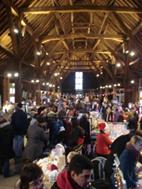
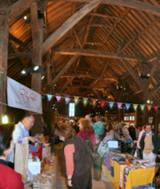
 station which was opened in 1912. The 16th century Great Barn at Manor Farm House, still survives nearby.*
station which was opened in 1912. The 16th century Great Barn at Manor Farm House, still survives nearby.*
Manor Farm House is a Grade II listed building, attracting many visitors every year. The house dates back to the 16th Century, and has origins in the Doomsday Book. Recent excavations (in 1997) uncovered the remains of the site of the Abbey of Bec’s Priory beneath the building. Opposite is a lovely 16th Century barn, which luckily for the local people is now home to Ruislip Library.
There are other outbuildings on this historic farm site dating as far back as the 13th Century. (Adapted from http://www.ukattraction.com/london/manor-farm-house.htm.
Manor Farm, Hillingdon's flagship heritage and culture site, houses a unique collection of community spaces and historic buildings set in 22 acres of beautiful grounds. Recently refurbished, Manor Farm is also home to craft workshops featuring a range of crafts, including pottery, an art gallery and tea rooms, a thriving education programme providing learning-based activities and projects for all ages, and indoor and outdoor events throughout the year. The Winston Churchill Theatre hosts a range of plays, shows, dances and lectures, and the Great Barn offers unequalled 12th century charm for concerts, weddings and social occasions. (Adapted from http://www.ents24.com/web/venue/Ruislip/Manor-Farm-32683.html).
Like Headstone Manor, Manor Farm in Ruislip is a moated farm, possibly the site of a motte and bailey castle. After that it was a priory and then a farm. The great barn was built about 1300 AD and is thought to be the oldest existing barn in London. Unlike the one in Harrow, it is an aisled barn. It is 36.5 metres long and 9 metres wide.
The barn is open on Sundays (http://www.greatbarns.org.uk/ruislip.htm). On the third Sunday of every month it hosts the picturesque craft Duck Pond Market: (http://www.duckpondmarket.co.uk/duckpondmarket.co.uk/Ruislip_DPM.html)
To know more about this interesting building, its detailed history and its architecture, please visit also: http://www.hillingdon.gov.uk/index.jsp?articleid=8991; http://en.wikipedia.org/wiki/Ruislip and The Ruislip Local History Society’s official website pages are: http://www.rnelhs.flyer.co.uk/timeline.htm and http://www.rnelhs.flyer.co.uk/index.htm
Ruislip is another medieval settlement of the area and it is first mentioned as Rislepein the Domesday Book of 1086; it appears again, in later years, as Ruslep (1227), Risselepe (1241) and Ruysshelp (1341). Its probable meaning is “leaping place (across the river) where rushes grow”. The name refers to a crossing of the river Pinn.*

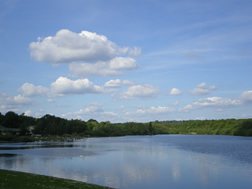
The Lake and the Beach: Ruislip Lido is a Victorian reservoir (it appears as a Reservoir in an Ordnance Survey map of 1822), with an artificial sand beach, surrounded by woodlands through which runs the miniature Ruislip Lido Railway. (Adapted from http://en.wikipedia.org/wiki/Ruislip). A large colony of ducks, swans, geese and other aquatic birds lives on the lake and the beach is very popular in the warm season. Ruislip Lido started as Ruislip Reservoir. It was opened on 5 December 1811 as one of the feeder reservoirs for the Grand Junction Canal by engineer John Rennie and constructor Hugh Mackintosh, and began feeding the Canal in 1816.
A suitable valley between Copse Wood and Park Wood was selected, dammed and then flooded. This resulted in a small village called Park Hearn being submerged beneath the water level of the reservoir.
The canal, now renamed the Grand Union Canal (see: http://en.wikipedia.org/wiki/Grand_Union_Canal), is located some distance to the west and a culvert was built to lead water to the canal at Hayes Bridge, which is seven miles from the Lido. Some of the route was underground and parts have been built over. Part of the route includes a little known aqueduct which carries the canal feeder over the River Pinn near Woodville Gardens. (Adapted from http://en.wikipedia.org/wiki/Ruislip_Lido).
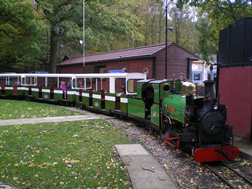
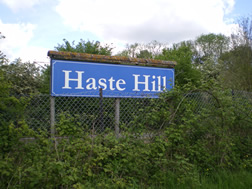
The Ruislip Lido Railway is a 12in (305mm) gauge miniature railway with diesel and steam locomotives, running about two thirds of the distance around the reservoir, just 14 miles (22.5 km) from the centre of London. The railway runs from the main station at Woody Bay by the Lido's beach, round a 1.5-mile (2.4 km) track around the lake, through the Ruislip woods, among beautiful trees, to Ruislip Lido Station near the "Water's Edge" restaurant and the Lido's car park. The sign on the platform at Ruislip Lido states "For Water's Edge and Car Park". The line runs through 2 disused stations (formally termini stations), these being Eleanor’s Loop and Haste Hill.
The section of track between Woody Bay and Wellington Junction is double track, with passing loops at Eleanor’s Loop and Haste Hill. These loops allow two-train operation on certain days of the year to take place. There is also a level crossing between Haste Hill and Ruislip Lido station. (Adapted from http://en.wikipedia.org/wiki/Ruislip_Lido_Railway).
You can find the interesting history of Ruislip Lido Railway at http://www.ruisliplidorailway.org/history and its complete map at http://www.buccabury.co.uk/ruislip/rlrmap.htm. For information on its present service (including timetables and tickets) please visit: http://www.ruisliplidorailway.org/. And here is an old video of the 80s: http://www.youtube.com/watch?v=P4thH_GQef0&feature=player_embedded#
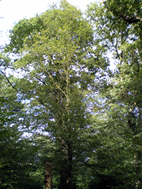
The Woods: These Woods are so old that they are recorded in the Domesday Book in 1068. They comprise mainly Oaks, Silver Birches, Hornbeam, Beech and Hazel trees.
There are many species of plants and flowers in the woods that are only found in ancient woodlands. The woods extend over a ten mile area and comprise four woodland areas, all quite different from each other. Some are quite dense and full of oaks and silver birches and others are more open, depending on the woodland management of each different area.
They are a wonderful place to walk and relax and you can walk for ages without seeing anyone. A rare haven of peace so close to London. (Adapted from http://www.ruislipwoods.co.uk/woods.htm).
This beautiful and comprehensive website (http://www.ruislipwoods.co.uk/) offers videos and many beautiful photos of this precious ecosystem, showing foxes, squirrels, birds, moths …
This ancient woodland is part of the Sites of Special Scientific Interest (SSSI), see http://en.wikipedia.org/wiki/Site_of_Special_Scientific_Interest for more information.
Northolt is first mentioned as Northealum in 960 (in Anglo-Saxon characters); it appears again as Northala (1086 – Domesday Book), Northale (1214), Northalle (1235), Northall alias Northolt (1631), meaning ‘northern nook(s) of land’, from Old English north and h(e)alh (with dative case plural –um in the 10th century form). ‘North’ distinguishes this place from neighbouring Southall, which contains the same word in spite of the contrasting modern spellings; indeed it will be noted that the final –t in Northolt (first appearing in the 17th century and no doubt influenced by the word holt ‘wood, thicker’) is quite unhistorical.*
Today Northolt is home to the Northolt Military Aerodrome (opened in 1915).
St Mary’s Church is a small medieval hilltop church serving as a reminder of rural Northolt. It dates from 13th century and was built on a site occupied since Saxon times. The restoration it underwent in 2007 includes work on the ceiling and internal and external walls.
St Mary's in Northolt is probably one of the most picturesque churches in one of the most picturesque settings in Middlesex. The church is built on a small hill overlooking a medieval green, and surrounded by green fields- giving it the same village setting, and feel, that it 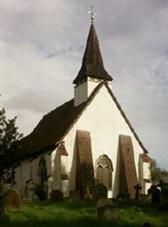 has had for over seven hundred years. (Adapted from http://www.northolt.org/).
has had for over seven hundred years. (Adapted from http://www.northolt.org/).
This is one of the three ancient churches that adorn the northern part of the borough (the others being Holy Cross, Greenford and St. Mary's Perivale). The parishes they served were largely rural up until the 30s at least, and so were spared the demolitions which were inflicted on many churches in the nineteenth century. When the population in these districts exploded, new churches were erected, thus saving the older buildings. In fact, there was no other Anglican church serving Northolt until as recently as 1954.
The body of the church is small, only 13 by 8 metres, though it was large enough for the medieval and the nineteenth century population of the parish. It dates from about 1300, though there was a church hitherto, as a priest is mentioned as being resident in 1086. There have been some sixteenth century additions, though. It is made from brick and flint. The south porch was rebuilt and a vestry added in 1945. The roof and turret were rebuilt in the sixteenth century.
Inside there is a fourteenth century font, given by Nicholas Brembre, a lord of the Manor and Lord Mayor of London and the Stuart coats of arms, probably dating from the restoration. There are also fifteenth and sixteenth century brasses, one of Henry Rowdell in a suit of armour, the other of John Gyfforde, his wife and 12 children.
(Adapted from www.ealing.gov.uk/services/leisure/local_history/historic_buildings/st_marys_northolt.html).
St Mary the Virgin is located on Ealing Road; it stands on a slope that originally overlooked the old village of Northolt and is situated adjacent to the site of a 15th century manor house. It is one of London's smallest churches, with a nave measuring only 44 feet (13 m) by 25 feet (7.6 m). The church was built around 1290 and was expanded over the following centuries, with the chancel being added in 1521; the spired bell tower was added in the 16th century and a gallery built at the west end of the church in 1703. Twin buttresses were erected against the west wall around 1718 to alleviate concerns that the church could slip down the hill. The internal beams are original and the bells date from the 17th century. The church was constructed from a variety of materials; the nave incorporates clunch (a type of limestone), flint and ironstone, and the mouldings of the doors and windows are made from Reigate stone.
Despite its small size, the church has played an important role in the ecclesiastical life of London: from the 13th century to 1873 its Rector served as the Bishop of London. It was the first Anglican parish to appoint a female Rector, the Reverend Pamela Walker. (Adapted from http://en.wikipedia.org/wiki/St_Mary_the_Virgin,_Northolt).
*All the etymological information given on this page comes from A.D. Mills, Dictionary of London Place Names, Oxford University Press, Oxford, 2010 (2001). This book is a precious source of information for all those interested in the origin of names and history of places in London and Greater London (available on Amazon).
![]()